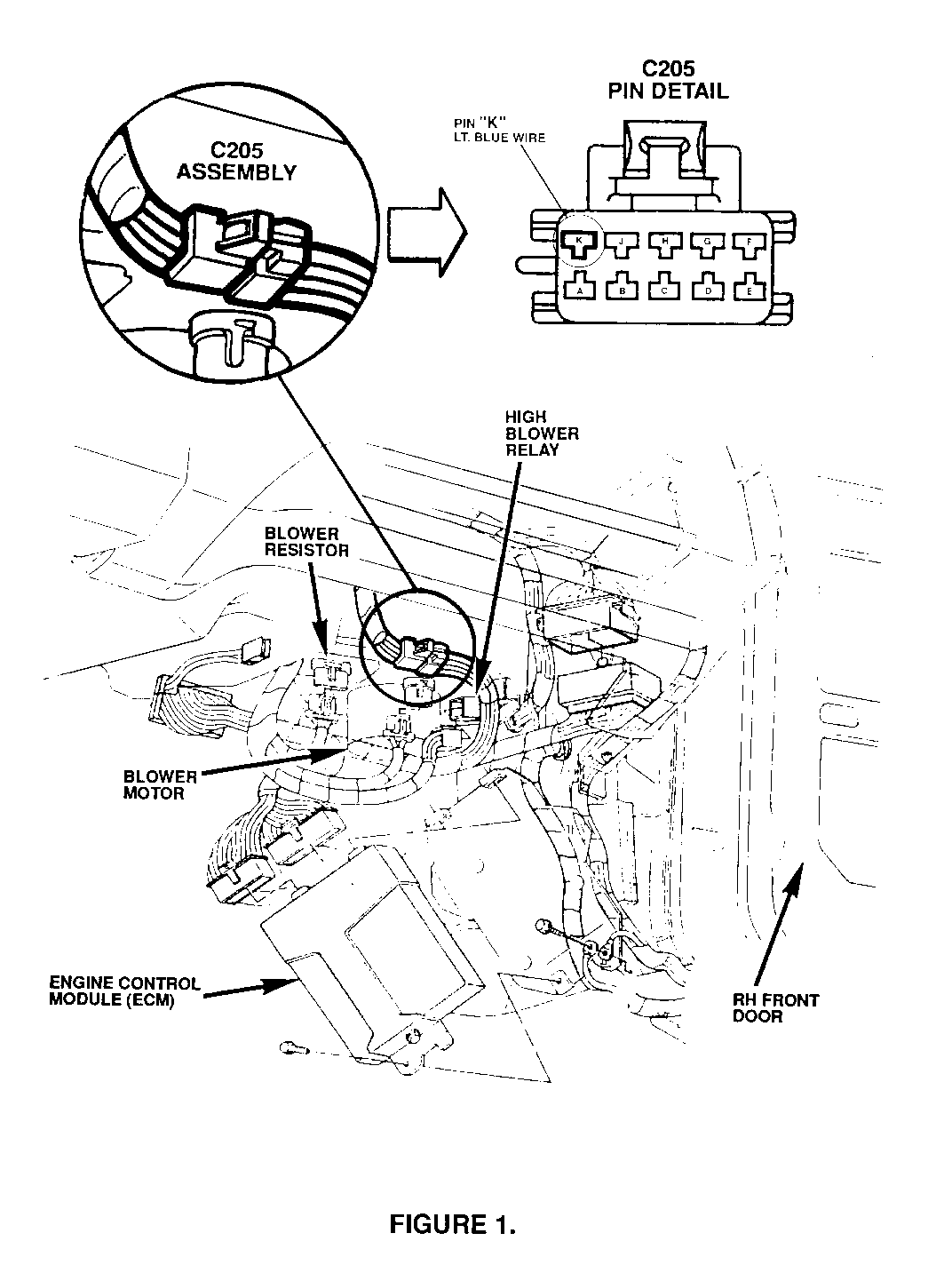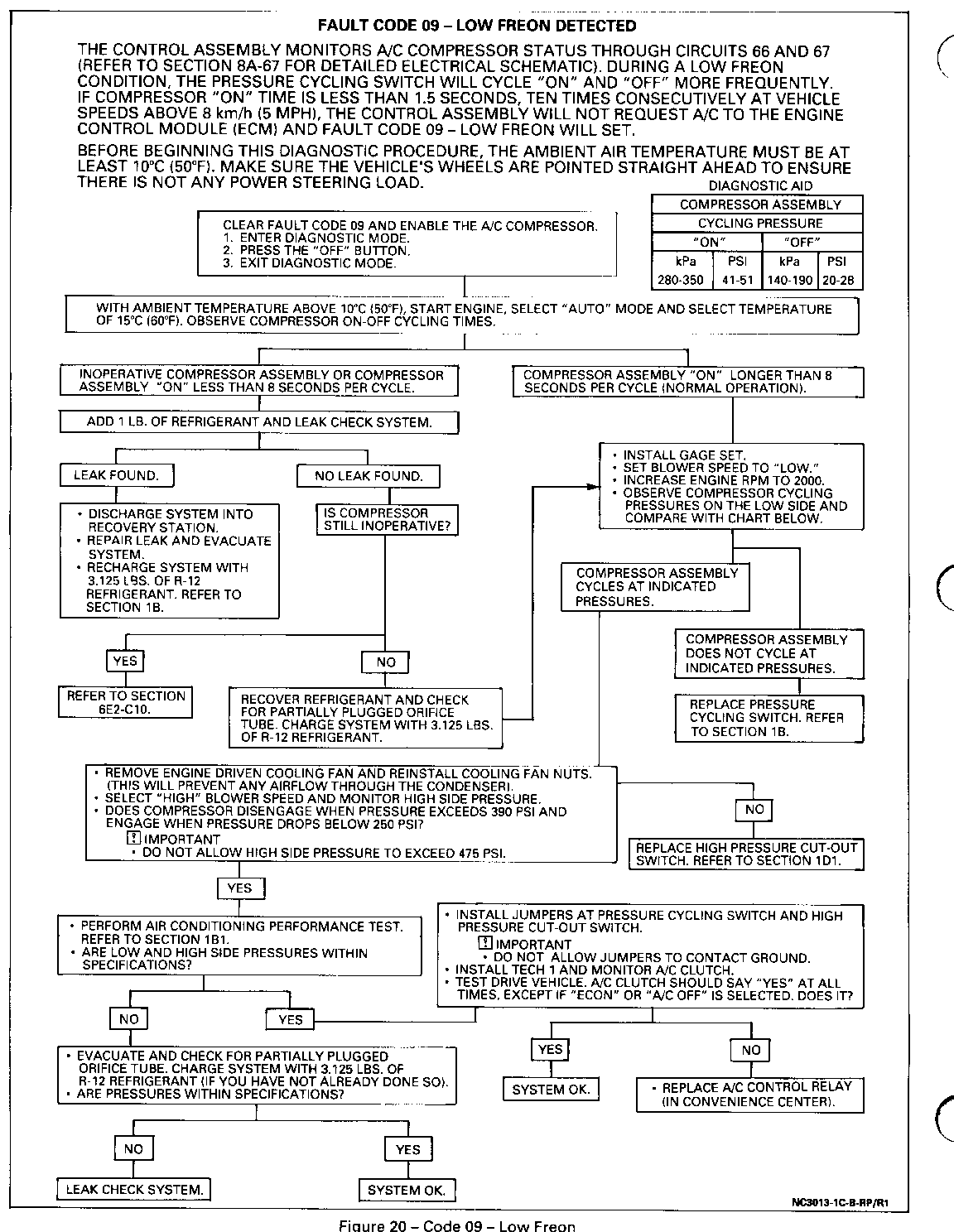INOP A/C COMPRESSOR CLUTCH (DIAG./CUT WIRE/SMU-SEC. 1C)

SUBJECT: INOP A/C COMP. CLUTCH (DIAGNOSE/CUT WIRE/ SMU - SECT. "1C")
MODELS AFFECTED: 1992-93 ROADMASTER AND ROADMASTER WAGON
1992 and '93 Roadmasters built before VIN PR404608, with the Electronic Air Conditioning Option (RPO C68).
NOTE: This bulletin includes an update to the 1991-92 Service Manual Section 1C.
CONDITION:
--------- The air conditioning (A/C) system may become inoperative when the air compressor clutch does not engage. This may also coincide with the "Degree Fahrenheit" or "Degree Celsius" flashing and the "ECON" graphic illuminating on the Electronic Air Conditioning Control Display. A Diagnostic Trouble Code (DTC) 9 (low Freon) may also be stored in the microprocessor of the Air Conditioning Control Assembly.
CAUSE:
----- The above conditions will occur when the microprocessor in the Electronic Air Conditioning System detects low Freon. However, a false DTC 9 may be set if the A/C control relay, high pressure cutout switch, or pressure cycling switch operate intermittently.
CORRECTION:
---------- A new diagnostic procedure (Pages 1C-26 and 1C-27 in the 1992 Buick Service Manual, and Page 1C1-24 in the 1991 Service Manual - copies attached) should be used to diagnose the above condition. This diagnostic procedure will determine if a false DTC 9 was set and stored. After the new diagnostic procedure has been performed, if system checks O.K., the following steps should be performed to disable the low Freon detection system of the Electronic Air Conditioning Control, to prevent a false DTC 9 being set by the microprocessor.
NOTE: This new procedure replaces "Figure 20 - Code 09 Low Freon Detected" in Section 1C of the Service Manual.
Low Freon detection will still be provided by the A/C Pressure Cycling Switch, as in the Manual Air Conditioning Systems. The DTC 9 must be cleared in order for the system to function properly.
To disable the Electronic Air Conditioning low Freon detection system:
1. Remove the lower passenger side hush panel.
2. Locate connector C205 (Figure 1).
3. Cut the wire (Lt. Blue) located in Pin K of connector C205 (Figure 1). Tape the cut wires back to the wire harness.
4. Reinstall lower hush panel.
WARRANTY INFORMATION:
Labor Operation No.: T1892
Labor Time: 0.9 HR.
This labor time includes diagnosis per chart (Figure 20). Refer to the appropriate Labor Code for replacement of any other component.
CODE 09 - Low Freon
Figures 20 and 21
Circuit Description
In the CCOT air conditioning system, the high pressure cut-off switch (46) and the A/C pressure cycling switch (47) inform the A/C control assembly microprocessor of the status of the refrigerant pressure in the A/C system. The refrigerant pressure is monitored through circuits 66 (C) and 67 (D). The A/C high pressure cut-off switch (46) opens when refrigerant pressure is above 2 700 kPa (390 psi). If the refrigerant system becomes low on Freon, the on-off frequency of the pressure cycling switch (47) increases. If the "on" time (closed position) of either the pressure cycling or high pressure cut-off switch (47 or 46) is less than 1.5 seconds for ten consecutive cycles when vehicle speed is above 8 km/h (5 mph), the A/C control assembly will set fault code 09 (low Freon) and disable the A/C control relay (21) located in the convenience center.
The A/C clutch coil (41) can only be energized by the A/C request signal from the A/C control relay (21) which is controlled by the A/C control assembly microprocessor (15): The A/C clutch coil can be disengaged by either the engine control module (ECM) (23) or by the A/C control assembly microprocessor (15). The ECM can disengage the A/C clutch coil through the compressor control relay (22), which is a disable (normally closed) relay, by energizing the relay. The A/C control assembly microprocessor (15) can disable the A/C clutch coil by disabling the A/C control relay (21) (normally open).
Once fault code 09 (low Freon) is set, the "Fahrenheit" or "Celsius" will be flashing and the "ECON" graphic will be displayed on the control assembly. The control assembly microprocessor (15) will not energize the A/C control relay (21) until fault code 09 (low Freon) is cleared, except under the following conditions:
o Fault code 09 is set.
o Vehicle speed is below 8 km/h (5 mph).
o "ECON" button is pressed.
The microprocessor will energize the A/C control relay and the "ECON" graphic will be extinguished. Once vehicle speed reaches 8 km/h (5 mph), and the "AUTO" or "ECON" or "DEFROST" button is pressed, the microprocessor remembers fault code 09 (low Freon) and de-energizes the A/C control relay (21). At this time, the "ECON" graphic will reappear and remain illuminated, regardless if "AUTO" or "DEFROST" button is pressed, until vehicle speed drops below 8 km/h (5 mph). Refer to revised Figure 20 for diagnosis of fault code 09 (low Freon). After diagnosis, refer to the appropriate service bulletin for disabling low Freon detection.
CODE 10 - Universal Asynchronous Receiver Transmitter (UART) Failure
Figures 21 and 22
Circuit Description
UART is composed of a serial data line leading from the engine control module (ECM) to the A/C control assembly microprocessor (15) and to the assembly line diagnostic link (ALDL). Three pieces of data is sent to the control assembly microprocessor (15) from the ECM through the UART line:
1. Engine coolant temperature
2. Vehicle speed
3. Engine RPM
The A/C control assembly (15) uses this information to help in controlling the interior temperature to the desired comfort level.
Fault code 10 indicates the A/C control assembly perceives a fault in the serial data it is receiving. Check for an open or a short in the UART data line. Refer to Figure 22 for UART failure diagnosis.



General Motors bulletins are intended for use by professional technicians, not a "do-it-yourselfer". They are written to inform those technicians of conditions that may occur on some vehicles, or to provide information that could assist in the proper service of a vehicle. Properly trained technicians have the equipment, tools, safety instructions and know-how to do a job properly and safely. If a condition is described, do not assume that the bulletin applies to your vehicle, or that your vehicle will have that condition. See a General Motors dealer servicing your brand of General Motors vehicle for information on whether your vehicle may benefit from the information.
